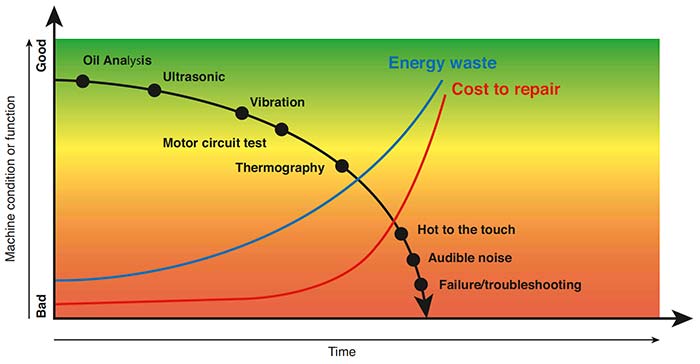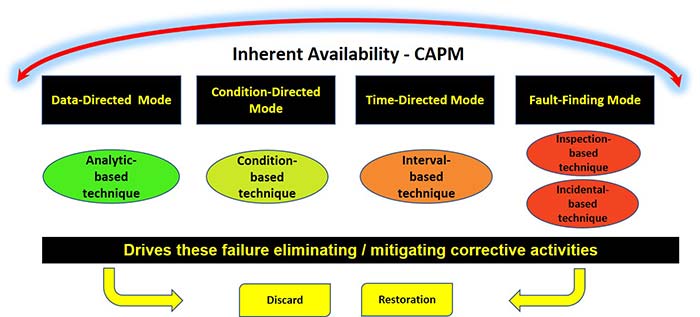This approach focuses on ensuring inherent reliability.
Fluke Accelix
12/03/2018
In maintenance and reliability, buzzwords and “new” methods arise frequently. Many companies look for a quick fix to what must be a team-wide culture shift. Information about what data really matters and how to execute maintenance and reliability strategies has often been missing. Many teams feel pressure to implement condition-based techniques when they may just be getting scheduled maintenance off the ground, or they do not begin because they cannot use condition monitoring on all assets. How can teams in various states of reactive, preventive and predictive strategies move forward on their reliability journey? One way is to focus on asset capacity assurance.
Glossary of Terms
Capacity: The maximum amount that something can contain or obtain Assurance: Confidence or certainty in the equipment’s ability to perform as designed Maintenance: The process of upkeep or preservation or the state of being maintainedDefining CAPM
Capacity assurance maintenance (CAPM) addresses where corrective maintenance activities exist within the potential failure (PF) curve (see Image 1) to ensure the inherent reliability of an asset or system. Capacity assurance (CAPA) considers the entire continuum of maintenance reliability, from design for reliability (DFR), implementation or commissioning, precision maintenance best practices all the way to the corrective maintenance realm. CAPM is only focused on addressing equipment maintainability and the modes for which maintenance addresses an asset’s inherent reliability. This will ensure that assets are operational when called upon. Image 1. The PF curve shows the failure curve and where on that curve condition monitoring technologies may detect the beginning of failure. (Images courtesy of Fluke Accelix)
Image 1. The PF curve shows the failure curve and where on that curve condition monitoring technologies may detect the beginning of failure. (Images courtesy of Fluke Accelix)Inherent Reliability
Inherent reliability (initial capability) is a measure of the overall “robustness” of a system or piece of equipment. It provides an upper limit to the reliability and availability that can be achieved. No matter how much inspection or maintenance is performed, the inherent reliability can never be exceeded. If end users operate, maintain and monitor a device as well as possible, they will be able to harvest all the inherent reliability of the asset. If operations and maintenance or monitoring practices have gaps, end users will harvest only some of the inherent reliability.1Inherent Availability
In reliability theory and reliability engineering, the term availability has the following meaning: The degree to which a system, subsystem or equipment is in a specified operable and committable state at the start of a mission, when the mission is called for at an unknown or random time.2 In other words—uptime. Availability is an important metric for assessing the performance of repairable systems, accounting for the reliability and maintainability of a component or system. Inherent availability is the steady state availability when considering only the downtime of an asset or system for corrective maintenance.CAPM Work Categorization
Corrective task modes are described below and shown in Image 2. Image 2. Corrective task modes
Image 2. Corrective task modesSecuring Inherent Reliability
Corrective work secures the inherent availability of any asset or system. This does not include proactive maintenance (also known as reliability based maintenance) that address processes not associated with maintenance-related activities. Examples of proactive maintenance are defect elimination, precision commissioning, precision installation, work processes and procedures, lubrication reliability, 5S and operating for reliability.One Solution: Connected Reliability
Teams want to ensure that their assets are available when needed. How can they move forward on the capacity assurance journey? The industrial internet of things (IIoT) can help maintenance and reliability (M&R) teams drive value and support them on the journey of maintaining inherent availability and CAPM. However, M&R leaders know that a wide gap exists in the adoption of IIoT technologies. Major barriers prevent the use of IIoT. A new concept of connected reliability overcomes those challenges, offering a practical roadmap that can lead to a true IIoT breakthrough. Connectivity of people to the systems and systems to assets anywhere and at all times through smart devices bridges this gap. Most companies that use IIoT technologies experience tangible business value, but only if they remove or mitigate the barriers to implementation, which include:- missing or inaccessible data
- reliance on scheduled routes
- lack of connectivity between data and asset management systems
- limited access to relevant data for timely, informed decisions
- comprehensive data collection
- end-to-end connectivity
- empowered teams

